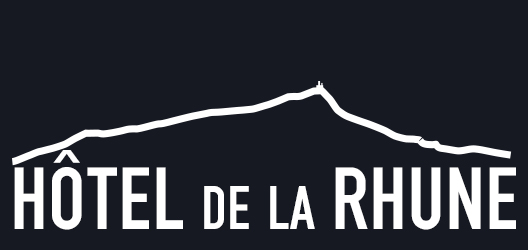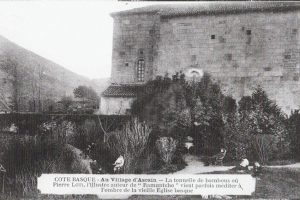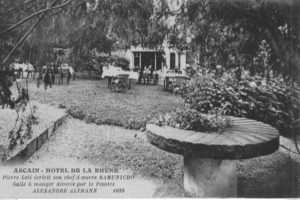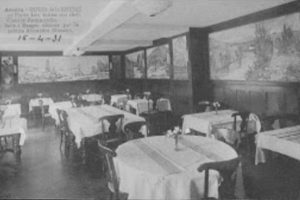Welcome ! Ongi etorri
In the heart of the Basque Country, in a quiet village far from the hustle and bustle of the Basque Coast, yet only a few kilometers away, we will welcome you to a family home steeped in history where, when you open your shutters in the morning, you will feel at a friend’s house. No frills.
The Hotel de la Rhune is told like a legend: Pierre Loti wrote Ramuntcho there, if you listen carefully you may hear the stories of the smugglers (the border is just behind the Rhune).
You will feel good with the Other, or with others.
In the garden or on the terrace in the shade of the arbor while you will see the pelota players compete on the pediment. Or as a family with children.
The hotel
Attached to the small town hall of Ascain, and in the shade of the church, the current Hôtel de la Rhune was originally a drinking establishment. Then Mr. Borda bought it and transformed the place into an inn with a few rooms. Jean-Pierre Borda was also known as a great hunter, great smuggler and great storyteller.
He was a friend of Pierre Loti. It was in one of the rooms of his hotel, overlooking the Rhune, that Pierre Loti wrote his novel Ramuntcho.
To the gate, which has since disappeared, were tied the customers’ horses or the mules which were used by tourists in their ascent of the Rhune. The hotel was the first house to have electricity.
New work took place in 1936 under the direction of André Pavlovsky, an architect of Russian origin.
One of the most inventive architects on the Basque Coast of the 1930s. Very famous on the Basque Coast, he built the most beautiful houses on the Coast for the wealthy clientele who frequented Biarritz and Saint Jean de Luz, built the two lighthouses of the entrance to the ports of Saint Jean de Luz and Ciboure the same year the Hotel was enlarged.
If you pay attention, you will see a plaque bearing his name sealed on the facade, at the junction between the old house and the new.
Go a little further and under the wisteria you will discover another plaque: the work of the sculptor Danglade, it represents Pierre Loti with a few words to signal his visit to the Hotel.
Ascain has always sheltered those who wanted to seek calm, far from the hustle and bustle of the coast. For example Ferdinand Pinney Earle (1878 – 1951), who was a famous film set designer in Hollywood from the 1910s to the 1920s. adobe buildings built in Santa Fe around 1920. Or General Charles Cunliffe Owen, whose imposing residence experienced intense social activity; Winston Churchill came to visit her. The dining room of the Hotel is decorated with paintings, works by the Russian painter Alexandre Altmann.
It is claimed that he only produced these works to pay his hotel bills. Then little by little the Hotel was modernized to become what it is today. But its owners have always wanted to keep its authentic appearance which makes it a house of character. No frills. Where you feel good because you intuitively breathe in all the conversations, all the encounters that have taken place there.
The village
The Hôtel de la Rhune is located in the heart of Ascain, a town in the Basque province of Labourd.
This small village, seven kilometers from the ocean, was built in a meander of the river “La Nivelle”, at the foot of the mountains: La Rhune, Esnaur and Biskarzun. If your room overlooks the square, you will see the pediment on the right: meeting place for the whole village for parties, pelota games or more simply to get together for a while.
Perhaps you will have the chance to hear some stories of smugglers… the village is on the border with Spain.
On the left the church inaugurated in 1626, some say by Louix XIII. One of the most beautiful churches in Labourd. And in the background the Rhune. “Our” mountain.
The one that is good to climb when you need to take refuge, to recharge your batteries: with each climb you find a different landscape as with each descent.
The climb is not very difficult (even Empress Eugénie has tried it several times!) and if you want, you can take the “petit train de la Rhune” to reach the summit (907 meters).
From there you will dominate the hills and mountains of Labour, Lower Navarre and Soule up to the peaks of the Pyrenees; and the Atlantic Ocean from Hendaye to Biarritz. And perhaps you will be lucky enough to see the “laminak”, the most popular little elf living in caves and at the water’s edge in Basque mythology… You will most likely meet the “pottok”, small Basque horses who live freely on the massif. Far from the hustle and bustle of the Basque Coast, but close to everything, Ascain proves to be an excellent base for a stay to discover the charm of the Basque Coast, the spell of the Basque Country, the liveliness of the Atlantic Ocean, the calm of the beaches.














